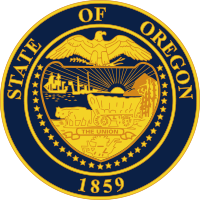Kalapuyan languages
| Kalapuya | |
|---|---|
| Ethnicity | Kalapuya people |
| Geographic distribution | Northwest Oregon |
| Linguistic classification |
Penutian ?
|
| Glottolog | kala1402[1] |
 | |
Kalapuyan (also Kalapuya) is a small extinct language family that was spoken in the Willamette Valley of Western Oregon, United States. It consists of three languages.[2]
Family division
Kalapuyan consists of
- 1. Northern Kalapuya † (also known as Tualatin–Yamhill)
- 2. Central Kalapuya † (several dialects, including Santiam)
- 3. Yoncalla † (also known as Southern Kalapuya)
Genetic relations
One of the boulders engraved with Kalapuyan words along the paths of east Alton Baker Park in Eugene, Oregon; this one is next to the Willamette River: Whilamut (meaning, Where the river ripples and runs fast)
Kalapuyan is usually connected with the various Penutian proposals, originally as part of an Oregon Penutian branch along with Takelma, Siuslaw, Alsea and Coosan.[3] A special relationship with Takelma had been proposed, together forming a "Takelma-Kalapuyan" or "Takelman" family.[4][5][6][7] However, an unpublished paper by Tarpent & Kendall (1998)[8] finds this relationship to be unfounded because of the extremely different morphological structures of Takelma and Kalapuyan.
References
- ↑ Hammarström, Harald; Forkel, Robert; Haspelmath, Martin, eds. (2017). "Kalapuyan". Glottolog 3.0. Jena, Germany: Max Planck Institute for the Science of Human History.
- ↑ Berman, H. (1990). An Outline of Kalapuya Historical Phonology. International Journal of American Linguistics, 56(1), 27-59.
- ↑ Sapir, E. (1921). A Characteristic Penutian Form of Stem. International Journal of American Linguistics, 2(1/2), 58-67.
- ↑ Frachtenberg, L. (1918). Comparative Studies in Takelman, Kalapuyan and Chinookan Lexicography, a Preliminary Paper. International Journal of American Linguistics, 1(2), 175-182.
- ↑ Swadesh, M. (1965). Kalapuya and Takelma. International Journal of American Linguistics, 31(3), 237-240.
- ↑ Shipley, W. (1969). Proto-Takelman. International Journal of American Linguistics, 35(3), 226-230.
- ↑ Kendall, D. (1997). The Takelma Verb: Toward Proto-Takelma-Kalapuyan. International Journal of American Linguistics, 63(1), 1-17.
- ↑ cited in: Mithun, Marianne. (1999). The languages of Native North America, pp. 432-433. Cambridge: Cambridge University Press.
Further reading
- Campbell, Lyle. (1997). American Indian languages: The historical linguistics of Native America. New York: Oxford University Press. ISBN 0-19-509427-1.
- Goddard, Ives (Ed.). (1996). Languages. Handbook of North American Indians (W. C. Sturtevant, General Ed.) (Vol. 17). Washington, D. C.: Smithsonian Institution. ISBN 0-16-048774-9.
- Jacobs, Melville (1945). Kalapuya Texts. University of Washington Publications in Anthropology. Volume 11. Seattle: University of Washington.
- Mithun, Marianne. (1999). The languages of Native North America. Cambridge: Cambridge University Press. ISBN 0-521-23228-7 (hbk); ISBN 0-521-29875-X.
- Sturtevant, William C. (Ed.). (1978–present). Handbook of North American Indians (Vol. 1-20). Washington, D. C.: Smithsonian Institution. (Vols. 1-3, 16, 18-20 not yet published).
External links
- The Verbal Morphology of Santiam Kalapuya (Northwest Journal of Linguistics)
This article is issued from
Wikipedia.
The text is licensed under Creative Commons - Attribution - Sharealike.
Additional terms may apply for the media files.
